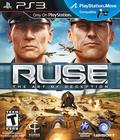After the juggernaut that is StarCraft II, you might not expect to see any more RTS games on the horizon, but Ubisoft's R.U.S.E. takes a different approach to genre conventions. Rather than offering up a cookie-cutter experience, R.U.S.E. attempts to take the focus off resource management and instead center the gameplay around strategy, combat maneuvers and straight-out bluffing. The best offense may just be one you don't really have.
The game is shipping on the PC as well as the consoles, but we recently sat down with the Xbox 360 version of R.U.S.E. to give it a spin. Playing through the introductory missions, we were shown the basic game mechanics as well as a handful of the trademark "ruses."
Ruses can be active or passive and can be used by both sides during the course of play. For example, one of the first ruses that players access is decryption. This ruse allows you to listen in on enemy communications and get advance notice on where the enemy units are headed. As soon as a direction order is given, a big red arrow shows up on the screen, indicating path and destination. Another early ruse is the spy. When activated, the spy ruse gives you a minute to take a look at all the unidentified units in a sector. This allows you to plan a detailed offense (or defense) against known units rather than being limited to just knowing if a unit is "light" or "heavy."
As you progress through the game, more advanced ruses become available, offering a bevy of different abilities. Ruses can be stacked, offering multiple effects at once, but each is limited to a single sector of the board at any given time. This helps ensure that no single ruse gives any player an unfair advantage. While you may be able to completely expose a given sector, your opponent may be doing the same in the next sector over … where you are completely blind.
Ruses are a time-based resource. You automatically bank a ruse after a given interval has passed. This allows players to mete out a constant stream of disinformation (such as sending over fake units to distract an enemy) or save up for one massive attempt at misdirection. Along those same lines, every ruse has a time-limited effect, so when you do use one, you want to make sure you're prepared to maximize its usefulness. There's no sense in firing off a ruse if you're not going to exploit it.
Unit selection within the game appears to be varied, with plenty of opportunity for attacking and counterattacking. Each unit has a weak spot that can be exploited by another unit. For example, infantry are horrible in a head-on fight with tanks, but when they set up an ambush, the infantry attack damage is tripled. A basic tactic involves hiding the infantry in the woods, where they will be invisible to your opponent (unless he happens to have a recon unit). Then, when the tanks roll on by, the infantry can blast them to smithereens.
Choice of units runs the gamut from antitank weapons to artillery, infantry, recon, planes and tanks. Individual subdivisions within each category offer even more options. While the single-player campaign appears to have you focusing on the American units, there are a total of six different armies in all that are available to play.
Outside of the campaign mode, R.U.S.E. offers multiplayer combat (facing off against other players or the A.I.) as well as a nifty mode that the developers call "Operation." Operation mode contains a number of scenarios that are designed to test your skills as a commander. They are intended to be more difficult than the standard campaign matches and can have you facing off against multiple A.I. opponents at once. Operation mode also offers co-op challenges, where you have to work together with another player to best the computer.
Multiplayer is one area where the console and PC versions of the game differ, with the console versions offering a maximum of four players, while the PC offers up to eight. Specific maps will also vary between the console and the PC.
Another area in which the versions differ is in the controls. While the PC version can be played with an Xbox 360 controller, this is the one area of the game where there will be the biggest learning curve. Since the consoles don't have mouse and keyboard support, playing with a controller is a necessity and to make it work, the developers implemented a quick-zoom scheme.
Basically, the entire map can be seen at any given time. Enemy units may be hidden by the fog of war, but whatever you can see is visible whether you are zoomed all the way in or all the way out. When pulled completely back, nearby units will automatically "stack," similar to poker chips, to represent the fact that they are nearby. Zoom in, and the stack separates out as soon as you get near. Once mastered, this setup can allow for some quick manipulation of individual units and groups, but it can be quite daunting at first blush. There are also a few curious control decisions that break standard conventions.
One of these involves moving a selected unit. In many RTS games, your units stay selected once you give a move order. This allows you to easily micromanage their patch across the battlefield. Here, as soon as you give a move order, your active group is automatically deselected. Another thing we noticed is that pressing the red B button on the Xbox 360 doesn't always close you out of every menu, as it does in other console titles. Instead, the build and ruse menus must be closed with the yellow Y button. By themselves, these changes are no big deal, but when the conventions have been drilled into players by other games over the years, it can be difficult to learn new methods and remember them in the heat of battle.
Many games strive to be original, but R.U.S.E. seems to be one of the few that actually breaks new ground instead of simply rehashing old material. There's certainly enough here to hook RTS veterans; the real question, though, is if the game has enough meat on its bones to hold interest after the novelty wears off. Be sure to check back next month for the full review, where we'll determine if the game has what it takes — or if all this innovation is merely a ruse.
More articles about R.U.S.E.











 R.U.S.E. is a strategy game in which the players use their brain as the ultimate weapon, fighting a war of perception, where the ability to deceive and mislead the enemy determines success. A first in a strategy game, R.U.S.E. reinvigorates the genre by using deception to give new-found depth to the game play.
R.U.S.E. is a strategy game in which the players use their brain as the ultimate weapon, fighting a war of perception, where the ability to deceive and mislead the enemy determines success. A first in a strategy game, R.U.S.E. reinvigorates the genre by using deception to give new-found depth to the game play.


























